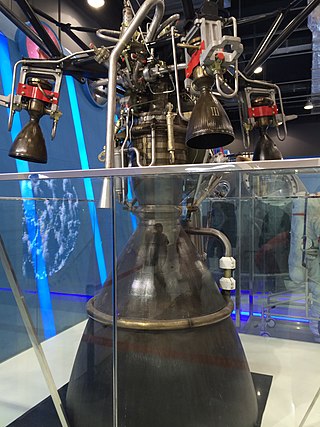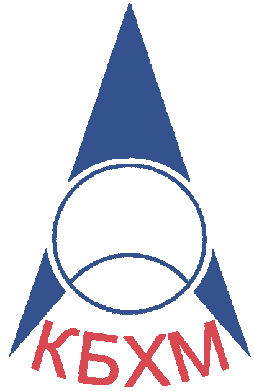Related Research Articles
The Long March 1D was a member of China's Long March rocket family. During the 1990s CALT developed an improved version of the DF-4 to test the reentry vehicle warheads of the DF-31. They took advantage of this development and offered it as the Long March 1D for commercial application. The modifications included:
The YF-75 is a liquid cryogenic rocket engine burning liquid hydrogen and liquid oxygen in a gas generator cycle. It is China's second generation of cryogenic propellant engine, after the YF-73, which it replaced. It is used in a dual engine mount in the H-18 third stage of the Long March 3A, Long March 3B and Long March 3C launch vehicles. Within the mount, each engine can gimbal individually to enable thrust vectoring control. The engine also heats hydrogen and helium to pressurize the stage tanks and can control the mixture ratio to optimize propellant consumption.
The RD-120 is a liquid upper stage rocket engine burning RG-1 and LOX in an oxidizer rich staged combustion cycle with an O/F ratio of 2.6. It is used in the second stage of the Zenit family of launch vehicles. It has a single, fixed combustion chamber and thus on the Zenit it is paired with the RD-8 vernier engine. The engine was developed from 1976 to 1985 by NPO Energomash with V.P. Radovsky leading the development. It is manufactured by, among others, Yuzhmash in Ukraine.

The RD-0210 (GRAU Index: 8D411K) is also known as the RD-465. It and its twin, the RD-0211, are rocket engines burning N2O4 and UDMH in an oxidizer rich staged combustion cycle. They have single nozzle, possess TVC and are the latest evolution in the RD-0203/4 lineage. They are the engines used on the Proton second stage. The RD-0213 is a fixed nozzle variation that is used on the RD-0212 module of the Proton third stage.

The Bell Aerosystems Company XLR81 was an American liquid-propellant rocket engine, which was used on the Agena upper stage. It burned UDMH and RFNA fed by a turbopump in a fuel rich gas generator cycle. The turbopump had a single turbine with a gearbox to transmit power to the oxidizer and fuel pumps. The thrust chamber was all-aluminum, and regeneratively cooled by oxidizer flowing through gun-drilled passages in the combustion chamber and throat walls. The nozzle was a titanium radiatively cooled extension. The engine was mounted on a hydraulic actuated gimbal which enabled thrust vectoring to control pitch and yaw. Engine thrust and mixture ratio were controlled by cavitating flow venturis on the gas generator flow circuit. Engine start was achieved by solid propellant start cartridge.
The YF-40 is a Chinese liquid rocket engine burning N2O4 and UDMH in a gas generator cycle. It has dual gimbaling combustion chambers.

The YF-20 is a Chinese liquid-fuel rocket engine burning N2O4 and UDMH in a gas generator cycle. It is a basic engine which when mounted in a four engine module forms the YF-21. The high altitude variation is known as the YF-22 is normally paired with the YF-23 vernier to form the YF-24 propulsion module for second stages. New versions when used individually for booster applications are called YF-25.
The YF-23 is a liquid rocket vernier engine, burning N2O4 and UDMH. It is used in along the YF-22 to form the YF-24 and YF-25 propulsion modules.
The FG-46 is a Chinese spin stabilized solid rocket motor burning HTPB. It was developed by China Hexi Chemical and Machinery Corporation for use in the Long March 2E on GTO missions. It first flew as a prototype SPTS-M14 on July 16, 1990 on the Badr A mission. It had its first commercial mission orbiting the AsiaSat 2 on November 28, 1995 and exactly one month later, on December 28 its second and last mission for EchoStar 1.
The CTS is an upper stage developed by the China Academy of Launch Vehicle Technology (CALT) to improve the performance of the Long March 2C to high LEO missions like SSO. The two stage LM-2 delivers the payload and stage to an elliptical orbit with the desired apogee and the CTS points the stack in the direction of the correct vector and activates the solid rocket motor (SRM) main engine to circularize it. It then dispenses the spacecraft and does a passivisation procedure.
The KTDU-35 was a Soviet spacecraft propulsion system composed of two liquid rocket engines, the primary, S5.60 (SKD) and the secondary S5.35 (DKD), fed from the same propellant tanks. Both engines burn UDMH and AK27I in the gas generator cycle. It was designed by OKB-2, the famous Isaev Design Bureau, for the original Soyuz programme.
Yuanzheng is a restartable upper stage developed by the China Academy of Launch Vehicle Technology (CALT) for the Long March rocket family.
The FG-15 was a Chinese spin stabilized apogee kick motor burning HTPB. It was developed by China Hexi Chemical and Machinery Corporation for use in the Dong Fang Hong 2 satellite bus for insertion into GSO orbit.
The FG-02 was a Chinese solid rocket motor burning Polysulfide. It was developed by China Hexi Chemical and Machinery Corporation for use in the Long March 1 third stage. It has a total nominal mass of 2,052 kg (4,524 lb), of which 1,806 kg (3,982 lb) is propellant load. It has an average thrust of 118 kN (27,000 lbf) with a specific impulse of 254 seconds burning for 38 seconds, with a total impulse of 4,500 kN (1,000,000 lbf). It used spin stabilization and a timing device to ignite in flight.

The KTDU-80 (Russian: Корректирующе-Тормозная Двигательная Установка, КТДУ) is the latest of a family of integrated propulsion system that KB KhIMMASH has implemented for the Soyuz since the Soyuz-T. It integrates main propulsion, RCS and attitude control in a single system pressure fed from a common dual string redundant pressurized propellant system. The common propellant is UDMH and N2O4 and the main propulsion unit, is the S5.80 main engine. It generates 2.95 kN (660 lbf) of thrust with a chamber pressure of 880 kPa (128 psi) and a nozzle expansion of 153.8 that enables it to achieve a specific impulse of 302 s (2.96 km/s). It is rated for 30 starts with a total firing time of 890 seconds. The integrated system without the pressurization or tanks weighs 310 kg (680 lb); it is 1.2 m (47 in) long with a diameter of 2.1 m (83 in).
The S5.80 is a liquid pressure-fed rocket engine burning N2O4/UDMH with an O/F of 1.85. It is used for crew-rated spacecraft propulsion applications. It is currently used in the Soyuz-TMA-M spacecraft propulsion module KTDU-80, and its sibling, the S5.79 rocket engine, is still used as the main propulsion of the Zvezda ISS module. The S5.80 generates 2.95 kN (660 lbf) of thrust with a chamber pressure of 0.88 MPa (128 psi) and a nozzle expansion of 153.8 that enables it to achieve a specific impulse of 302 s (2.96 km/s). It is rated for 30 starts with a total firing time of 890 seconds. The engine, without the pressurization system or propellant tanks, weighs 310 kg (680 lb) and is an integrated unit that is 1.2 m (47 in) long with a diameter of 2.1 m (83 in).

The A.M. Isayev Chemical Engineering Design Bureau, also known as KB KhimMash or just KBKhM, is a Russian rocket engine design and manufacturing company. It is located in the city of Korolyov. It started as the OKB-2 division of the NII-88 research institute, where A.Isaev directed the development of liquid rocket engines for ballistic missile submarines.

FSUE Research and Development Institute of Mechanical Engineering, also known as NIIMash, is a Russian rocket engine design and manufacturing company specialized in small thrusters. It is located in the city of Nizhnyaya Salda, Sverdlovsk Oblast. It started as the B-175 factory of the NII-1 research institute, where Mikhail G. Mironov directed the development of liquid rocket engines research and testing.
The RD-0255 is a propulsion module composed of an RD-0256 main engine and a RD-0257 vernier engine. Both are liquid rocket engine, burning UDMH in N2O4. The RD-0256 main engine operates in the oxidizer rich staged combustion cycle, while the vernier RD-0257 uses the simpler gas generator cycle. It was used on the R-36MUTTKh (GRAU:15A18) and R-36M2 (GRAU:15A18M). Subsequently, it has been in the Dnepr second stage and as of 2016 it is still in active service.
The RD-864 is a Soviet liquid propellant rocket engine burning UDMH and nitrogen tetroxide in a gas generator combustion cycle. It has a four combustion chambers that provide thrust vector control by gimbaling each nozzle in a single axis ±55°. It is used on the third stage of the R-36M UTTKh and Dnepr. For the R-36M2, an improved version, the RD-869 was developed.
References
- ↑ Norbert Bgügge. "Asian space-rocket liquid-propellant engines". B14643.DE. Archived from the original on 2015-07-17. Retrieved 2015-07-25.
- 1 2 3 4 5 6 7 8 9 Norbert Bgügge. "Propulsion CZ-1". B14643.DE. Retrieved 2015-07-25.
- 1 2 3 4 5 Norbert Bgügge. "The Chinese DF-3 missile". B14643.DE. Archived from the original on 2015-10-17. Retrieved 2015-07-25.
- ↑ "Long March". Rocket and Space Technology. Retrieved 2015-07-25.
- ↑ "CZ-1". Encyclopedia Astronautica. Archived from the original on May 1, 2002. Retrieved 2015-07-25.
- ↑ "YF-2A". Encyclopedia Astronautica. Archived from the original on 2015-08-24. Retrieved 2015-07-25.
- ↑ "YF-3". Encyclopedia Astronautica. Archived from the original on 2015-08-24. Retrieved 2015-07-25.
- ↑ Harvey, Brian (2004). "Launch Centers Rockets and Engines". China's Space Program — From Conception to Manned Spaceflight. Springer Science & Business Media. p. 230. ISBN 978-1852335663 . Retrieved 2015-07-15.
- ↑ Mowthorpe, Matthew (2004). "Chinas Military Space Program". The Militarization and Weaponization of Space. Lexington Books. p. 90. ISBN 978-0739107133 . Retrieved 2015-07-15.
- 1 2 3 "Dong Feng-3 (CSS-2)". SinoDefence. Archived from the original on 2015-11-23. Retrieved 2015-07-25.
- ↑ "Dong Feng-4 (CSS-3)". SinoDefence. Archived from the original on 2015-11-23. Retrieved 2015-07-25.
